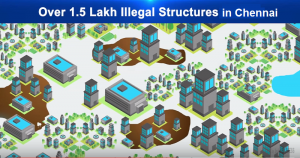
Chennai Floods: Unfortunate Exhibit Of The Perfect Storm Created By Climate Change And Shoddy Urban Planning
The Indian city of more than 4.6 million residents saw its heaviest rainfall in a century. The unprecedented magnitude of Chennai floods has once again raised the same questions that are asked after every such disaster in the country. Is it an adverse impact of global warming and the climate change? Or is this a case of poor urban planning?

Both, say experts. Climate change is probably linked to its cause, and short-sighted urban planning is certainly connected to the impact of such disasters.
Last week, as world leaders met in Paris to discuss climate change, the Indian coastal city of Chennai was drowning. At the COP21 talks in Paris, Chennai has been brought up as an unfortunate exhibit of the perfect storm created by climate change and shoddy urban planning.
Why are the #COP21 climate talks so important? This picture of Chennai, India right now explains….. pic.twitter.com/aFrkJvhOvJ
— Jenny Ricks (@jenny_ricks) December 2, 2015
#COP21 coincides w/t floods in southern India. Chennai got 276 mm rain 2 Dec, 34 times normal of 8 mm. More to come pic.twitter.com/Z1wjF0TNsP
— WMO | OMM (@WMO) December 3, 2015
Chennai Rains
On December 2, Chennai saw 34 times the normal daily amount of rain that caused floods in the city. The record-breaking rains in the city attributed to this season’s excessive rain in the country’s southeastern region partly to this year’s strongest-ever. This has raised several questions over its urban planning and role of the state government towards implementing policies to prevent unplanned constructions and preserving the wetlands.
Adverse impact of global warming and the climate change
“One of the most confidently predicted consequences on warming land and oceans are an increase in evaporation that could provide more fuel for more intense rainstorms on land. The recent extreme rains in Chennai surely seem to fit that trend,” Holthaus told The Hindu
“An individual episode like that on December 1 is a combination of several factors and in every such episode, the combination changes. On December 1, the lower-level moisture supply was high and upper air evacuation of the moisture was also strong. We call this phenomenon upper air divergence, and the effect is that the cloud becomes very intense. Both coincide very rarely,” B. Mukhopadhyay of the India Meteorological Department in Pune said.
But while the resulting rain was unprecedented, the flooding wasn’t. Chennai has seen serious flooding several times before, and the local government has not learned its lessons. State Chief Minister Jayalalitha called the damage this time around “unavoidable.” Facts on the ground, however, suggest the contrary.
Poor Urban Planning
Many urban development experts feel that illegal structures over the years and poor urban planning are among the key reasons behind the havoc in Chennai. As per the government’s report, nearly 1.5 lakh illegal structures came out around Chennai, which led to the disappearance of more than 300 water bodies. The matter was raised several times but the government failed to take any punitive measures. Such rampant and illegal construction also led to improper drainage system in the city.
Even the city’s airport, which had to be temporarily shut down during the floods, was built on the flood basin of one of the rivers running through the city. Chennai’s mass rapid transit line runs above the Buckingham Canal. And tech facilities have been built on the banks of lakes.
In 2009, the state government has spent nearly Rs 1,447.9 crore on interconnecting storm water drains and ensuring lake overflows go into the three main rivers. These fixes were supposed to be completed in 2013, but during that period, the state government got virtually nothing done. In August 2015, the city also announced that it would be developing an early flood-warning system, but that’s now too little, too late.
Here is a video made by the Indian Express summarizing all the climate change and urban planning related problems that led to the devastation in Chennai
At the Paris talks, India is already driving the conversation about the global effort to reduce climate events. But hopefully, the impact of this latest flood will also force local leaders to face the urban problems they’ve put off far too long.